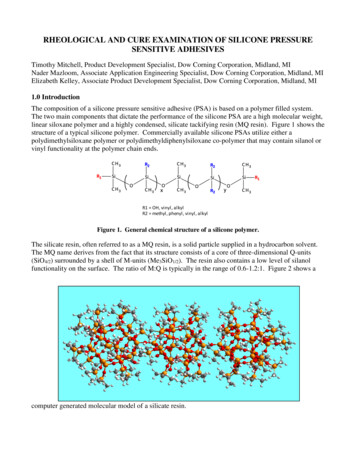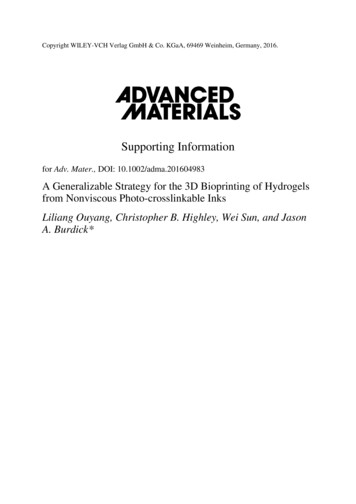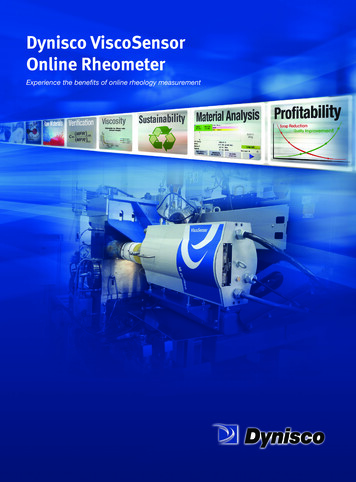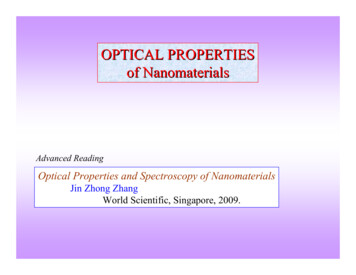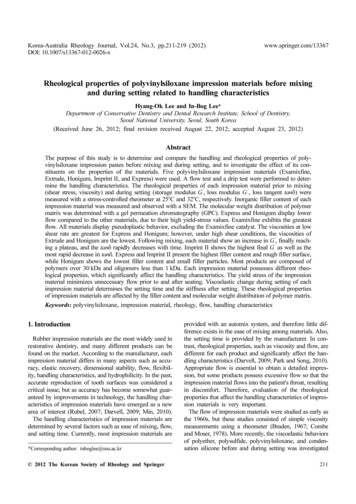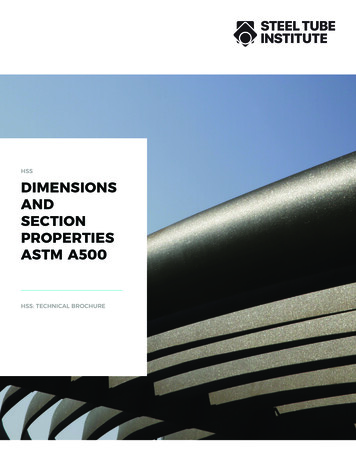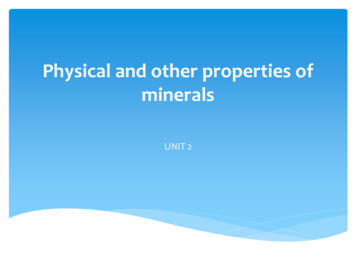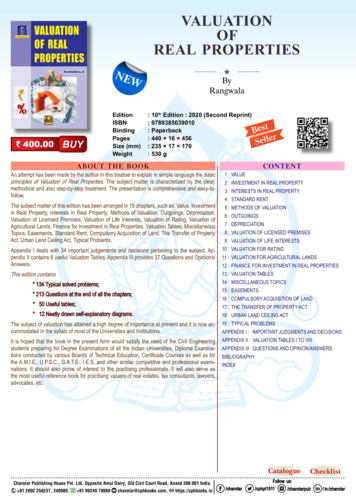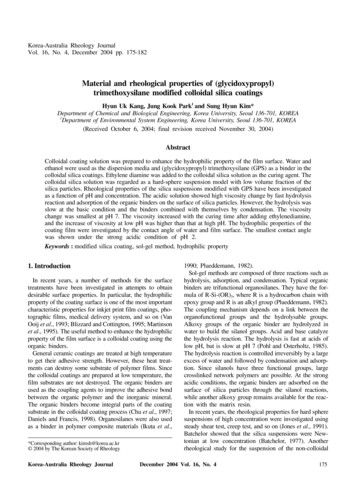
Transcription
Korea-Australia Rheology JournalVol. 16, No. 4, December 2004 pp. 175-182Material and rheological properties of (glycidoxypropyl)trimethoxysilane modified colloidal silica coatingsHyun Uk Kang, Jung Kook Park1 and Sung Hyun Kim*Department of Chemical and Biological Engineering, Korea University, Seoul 136-701, KOREA1Department of Environmental System Engineering, Korea University, Seoul 136-701, KOREA(Received October 6, 2004; final revision received November 30, 2004)AbstractColloidal coating solution was prepared to enhance the hydrophilic property of the film surface. Water andethanol were used as the dispersion media and (glycidoxypropyl) trimethoxysilane (GPS) as a binder in thecolloidal silica coatings. Ethylene diamine was added to the colloidal silica solution as the curing agent. Thecolloidal silica solution was regarded as a hard-sphere suspension model with low volume fraction of thesilica particles. Rheological properties of the silica suspensions modified with GPS have been investigatedas a function of pH and concentration. The acidic solution showed high viscosity change by fast hydrolysisreaction and adsorption of the organic binders on the surface of silica particles. However, the hydrolysis wasslow at the basic condition and the binders combined with themselves by condensation. The viscositychange was smallest at pH 7. The viscosity increased with the curing time after adding ethylenediamine,and the increase of viscosity at low pH was higher than that at high pH. The hydrophilic properties of thecoating film were investigated by the contact angle of water and film surface. The smallest contact anglewas shown under the strong acidic condition of pH 2.Keywords : modified silica coating, sol-gel method, hydrophilic property1. IntroductionIn recent years, a number of methods for the surfacetreatments have been investigated in attempts to obtaindesirable surface properties. In particular, the hydrophilicproperty of the coating surface is one of the most importantcharacteristic properties for inkjet print film coatings, photographic films, medical delivery system, and so on (VanOoij et al., 1993; Blizzard and Cottington, 1995; Martinsonet al., 1995). The useful method to enhance the hydrophilicproperty of the film surface is a colloidal coating using theorganic binders.General ceramic coatings are treated at high temperatureto get their adhesive strength. However, these heat treatments can destroy some substrate of polymer films. Sincethe colloidal coatings are prepared at low temperature, thefilm substrates are not destroyed. The organic binders areused as the coupling agents to improve the adhesive bondbetween the organic polymer and the inorganic mineral.The organic binders become integral parts of the coatingsubstrate in the colloidal coating process (Chu et al., 1997;Daniels and Francis, 1998). Organosilanes were also usedas a binder in polymer composite materials (Ikuta et al.,*Corresponding author: kimsh@korea.ac.kr 2004 by The Korean Society of RheologyKorea-Australia Rheology Journal1990; Plueddemann, 1982).Sol-gel methods are composed of three reactions such ashydrolysis, adsorption, and condensation. Typical organicbinders are trifunctional organosilanes. They have the formula of R-Si-(OR)3, where R is a hydrocarbon chain withepoxy group and R is an alkyl group (Plueddemann, 1982).The coupling mechanism depends on a link between theorganofunctional groups and the hydrolysable groups.Alkoxy groups of the organic binder are hydrolyzed inwater to build the silanol groups. Acid and base catalyzethe hydrolysis reaction. The hydrolysis is fast at acids oflow pH, but is slow at pH 7 (Pohl and Osterholtz, 1985).The hydrolysis reaction is controlled irreversibly by a largeexcess of water and followed by condensation and adsorption. Since silanols have three functional groups, largecrosslinked network polymers are possible. At the strongacidic conditions, the organic binders are adsorbed on thesurface of silica particles through the silanol reactions,while another alkoxy group remains available for the reaction with the matrix resin.In recent years, the rheological properties for hard spheresuspensions of high concentration were investigated usingsteady shear test, creep test, and so on (Jones et al., 1991).Batchelor showed that the silica suspensions were Newtonian at low concentration (Batchelor, 1977). Anotherrheological study for the suspension of the non-colloidalDecember 2004 Vol. 16, No. 4175
Hyun Uk Kang, Jung Kook Park and Sung Hyun Kimspherical particles in the polymer solutions was also carried out (Kim, 2001). Effect of the organic binder on viscosity of the polymer resin system is influenced bycoupling reactions. However, there are few rheologicalstudies for the suspension system with organic binder.In this study, the hydrophilic property of the film surfacewas pursued by the colloidal silica solution, and ethylenediamine as a curing agent. Objectives of this study areto describe the relation between the material properties ofcoatings and the rheological properties of solution. In addition, effects of initial solution pH and composition of solution are discussed briefly.2. Experiments2.1. MaterialsA commercial silica suspension (Ludox-LS, Aldrichchemicals) was used to prepare the coating media. LudoxLS consisted of 30 wt% silica colloid particles (12 nmaverage diameter) and 70 wt% water. pH of Ludox-LS suspension was measured at 9.6, because base was added tostabilize the suspension. 3-(Glycidoxypropyl) trimethoxysilane (GPS, Aldrich Chemicals) was used as an organicbinder, where GPS monomer has three methoxy groups forhydrolysis and one epoxy group for curing. The methoxygroups are hydrolyzed by water, form the silanol group andcombine with the hydroxyl group of silica particle in solution. The organic chains react with the curing agents of ethylenediamine and form the crosslinked structures on thefilm surface. Ethanol was added to solution to increase thesolubility of the organic binder for water. These reactionmechanisms were shown simply in Fig. 1.To prepare a suspension for coating, water was added tothe as-received suspension to make the Ludox-LS of thewater mass ratio of 1 : 1. This suspension was diluted withethanol. After stirring the suspension for 20 minutes, GPSwas added, and GPS concentrations varied from zero to ahalf of silica particle weight. Acid or base was added as acatalyst followed by GPS. pH was adjusted with nitric acidand ammonia water. The reaction was terminated after 24hours and then ethylenediamine was added as a curingagent. Coatings were made from the suspension of approximately 20 cP viscosity by the dip coating method. Thespeed of the dip coating was fixed at 7.8 mm/sec. Polyethylene terephthalate (PET) film was used as a substrateand the coated PET film was dried in an air convectionoven for 1 hour at 80oC. Flow chart for preparation of coating film was shown in Fig. 2.2.2. CharacterizationsThe solution viscosity was measured by the viscometer(Brookfield DV II LV with adapter) and the rheometerFig. 1. Reaction mechanism of sol-gel method.176Korea-Australia Rheology Journal
Material and rheological properties of (glycidoxypropyl) trimethoxysilane modified colloidal silica coatingsFig. 3. pH change for reaction time (WR 0.33).Fig. 2. Experimental procedure.(TA Instruments AR2000) at 30oC. Prior to the rheologicalcharacterization, the suspensions were stirred for 20 minutes, because nanoparticles had a higher tendency toagglomerate due to the interparticle interactions of nanoparticles. This stirring process ensured that the suspensionwas adequately homogenized. After stirring for 20 minutes, the flow behaviors of the suspension were characterized under the steady shear flow. The viscoelasticproperties of the suspensions were determined by the oscillatory shear tests with rheometer. Contact angle goniometer(ERMA G-1 and Kyowa Interface Science CA-DT) wasused to monitor the hydrophilic property of films. Thedeionized water was used to measure the contact angle onthe film surface. The surface microstructures of film andpowder were observed by the field emission scanning electron microscope (Hitachi FE-SEM 4300). Before SEMexamination, the films were dried in an air convection ovenfor 1 hour at 80oC.3. Results and discussion3.1. Properties of suspensionsThe material properties of suspension and filmsdepended on the initial pH of suspension. As mentionedabove, GPS monomer has three methoxy groups and oneepoxy group. When GPS is added to water, three methoxygroups are hydrolyzed. After hydrolysis, the condensationreaction occurred at GPS monomers to form the oilgomers.The hydrolysis rate was high in strong acid and base witha minimum value at pH 7. Adsorption was faster at acidwhile condensation was faster at higher pH 8.pH and viscosity changes of solution are shown in Figs.3 and 4 where WR is the weight ratio of GPS to silica particles. pH change of solution at strong acid of pH 2 wasvery small, but increased slowly at higher pH of 4, 5, andKorea-Australia Rheology JournalFig. 4. Viscosity change for reaction time (WR 0.33).6. Under acidic condition, an initial hydrolysis of GPS wasrelatively rapid and finished after about 1 hour. Then theycondensed to higher oligomers for about 4 hours. pHchange shown in Fig. 3 is caused by these reaction mechanisms. The viscosity changes in Fig. 4 show that the reaction rate is increasing at strong acid and at base moredramatically where ηs is the solution viscosity withoutGPS. The relative viscosity (η/ηs) change of 3% at pH 7means that the hydrolysis is very slow at pH 7 and the ratedetermining reaction. However, the viscosity change at pH3 or pH 9.6 was about 12% while reaction is fast at strongacid of pH 3 and base of pH 9.6 due to the catalysts of acidand base. These conditions were related to the materialproperties of the coated film.The viscosity as a function of the shear rate is shown inFig. 5 for the colloidal suspension. The colloidal suspen-December 2004 Vol. 16, No. 4177
Hyun Uk Kang, Jung Kook Park and Sung Hyun KimFig. 5. Viscosity as a function of shear rate for different time(WR 0.33).Fig. 6. Storage and loss modulus as functions of angular frequency for the suspensions.sions showed the shear thinning behavior, but they exhibited more and more unstable properties at low shear rates.At small shear rates, the inter-particulate forces dominateover the hydrodynamic forces relatively, so that the rheological response is dependent on the resulting structuralinteraction. As the shear rate was increased, the hydrodynamic forces also were increased due to the flowinduced structuring of the nanoparticles and the viscositywas decreased at high shear rates. Since the silica particlesand the organic binders (GPS) combined each other withtime, the colloidal particle size was increased, and the colloidal suspensions exhibited more and more high viscositywith the increase of the reaction time and showed Newtonian behavior.The storage and loss modulus of colloidal suspensionsare shown in Fig. 6 for different pH. The viscous properties are dominant at low frequency. Two functionsintersected at a characteristic frequency, and the elasticproperties were dominant above this frequency. The lossmodulus G" was independent of the reaction time for different pH. However, the storage modulus change wasdependent on the pH of suspensions. The difference ofstorage modulus between time t 0 and t 1 hour wasvery small at pH 2, but it was large at pH 9.6. The elasticproperties of the colloidal suspension were effected notthe silica particles but the GPS, because the amounts ofsilica particles were not changed during the reaction. Asmentioned in the previous section, after GPS hydrolyzedwith water, it was absorbed on the silica particle quicklyat low pH. So there were very small free GPS to com-178Korea-Australia Rheology Journal
Material and rheological properties of (glycidoxypropyl) trimethoxysilane modified colloidal silica coatingsFig. 8. Viscosity as a function of volume fraction of silica particles at pH 2.Fig. 7. Viscosity for curing time at different pH.bine each other. The elastic properties of the suspensionswere not changed with reaction time by these results. Onthe other hand, GPS was combined each other andformed oligomers at high pH, and the stored deformationenergy (elastic property) of the suspensions was changedwith reaction time.Fig. 7 shows the viscosity change after the addition ofethylenediamine. The viscosity of suspension wasincreased abruptly under the acidic condition and the elastic response to stress appeared during gelation. The viscosity was increased fast under the acidic condition,because the adsorption reaction of GPS on the surface ofthe silica particle was fast at acid and then the silica particles were combined with each others strongly by lots ofGPS molecules on surface. Since the condensation reactionamong GPS molecules was faster under the basic conditions, there were small GPS molecules on the surface byadsorption. So the bonds with other silica particles wereweak at base.The viscosity as a function of the particle concentrationswas shown in Fig. 8. The best-fit line for experimental dataof Fig. 8 was given byηr 1 12.7 Φ*(1)where Φ was the particle volume fraction without consideration of the hydrodynamic volume. The dash straightline was given by Batchelor’s expression, i.e.,*ηr 1 2.5 Φ 6.2 Φ 2(2)where Φ was the hydrodynamic volume fraction of particles in the suspension. Then the hydrodynamic volumefraction is calculated as followsΦ weight concentration specific volumeKorea-Australia Rheology Journal(3)The specific volume of 5.0 ml/g was estimated from theslope of Fig. 8. This specific volume is higher than that ofprevious report (de Kruif, et al., 1985), but the trend wassimilar to other studies. The difference between the best fitline and previous report was caused by the particle size difference. A hydrodynamic volume can be influenced by themicropores and liquid layering on the particles surface.However, there were few pores in our experiments,because the pores were closed off by siloxane bridges(Jones, Leary, and Boger, 1991).Properties of coating filmpH conditions and suspension compositions determinethe surface modification. The coating microstructures consisted of silica colloids and GPS. At low R values, most ofGPS are adsorbed on the surface of silica particles in thesuspension. However, as the amount of GPS increases, theunadsorbed GPS keeps further condensation reaction. Themicrostructures which show the cracking behavior of colloidal coatings are influenced by modifications of GPS, theaddition of GPS and curing agents.Fig. 9 shows SEM images of the coating surfaces prepared from the silica solution with GPS (R 0.2) added atdifferent pH. The SEM results indicated that even thoughthe organic binder (GPS) was added to the colloidal suspension, the surface morphology of coating films dependedon the pH used for the modification of the silica particleswith GPS. The coating prepared from the acidic suspension(pH 2) showed the smooth surface without cracking. Underthe basic conditions, GPS was condensed quickly and didnot adsorb on the surface of the silica particle. Finally, theyadhered poorly on the surface of PET film and there werelots of cracks after drying. These results indicated thataddition of the GPS did not affect on the strength betweenDecember 2004 Vol. 16, No. 4179
Hyun Uk Kang, Jung Kook Park and Sung Hyun KimFig. 9. SEM photographs of the coating surfaces prepared at different pH (WR 0.2).silica particles. The coatings prepared under the acidic conditions and the ethylenediamine addition gave good results,because these conditions led to adsorption of GPS on thesurface of silica particles and allowed the strong formationof amine-epoxy bonds.The hydrophilic property of the coating films was confirmed by the contact angle measurement. Figs. 10 and 11180show the contact angle of the films with GPS added at different pH. The contact angles of the coating films weredependent on the pH of suspension. Especially, in the caseof the coating films prepared under highly acidic condition(pH 1 and 2) the contact angles were very small. It seemsthat the hydrophilic property of the coating film may bephysically related to the surface morphology of the coatingKorea-Australia Rheology Journal
Material and rheological properties of (glycidoxypropyl) trimethoxysilane modified colloidal silica coatingsadsorption on the surface of silica particle was faster thancondensation reaction at acid, GPS was adsorbed on thesurface initially and then combined with GPS each other.The epoxy groups on the surface of the silica particle werelarge and the adhesive properties of the silica particleswere better at strong acid, because the amount of GPS onthe surface at strong acid was larger than the amount atweak acid or base.4. ConclusionsFig. 10. Contact angles of surface as a function of solution pHfilm. A contact angle of water on the film surfacedepended on the crack and roughness of the film surface.The smooth surfaces were observed in the coating filmsprepared under the acidic condition, while the rough surfaces were obtained under the basic condition. Since theA suspension was prepared to coat the organic film for thehydrophilic properties. Interactions between GPS and silicaparticles in the suspension have been affected three reactionmechanisms of hydrolysis, adsorption and condensation.Viscometer was used to verify the reaction mechanism andto observe the material properties of the suspension. Theloss modulus changes were small under both conditions, butthe storage modulus change under basic condition waslarger than that under acidic condition. Since the elasticproperties of the colloidal suspension were effected not thesilica particles but the GPS, the reaction mechanisms couldbe proved from those rheological results.The suspension pH and amounts of GPS were both critical processing parameters for controlling the materialFig. 11. Contact angle images of surface as a function of solution pH.Korea-Australia Rheology JournalDecember 2004 Vol. 16, No. 4181
Hyun Uk Kang, Jung Kook Park and Sung Hyun Kimproperties. Addition of GPS as the organic binder in the silica solution caused the decreasing of cracks on the filmsurface at strong acid. Amounts of GPS were not importanteffects at pH 4 or higher pH. Coatings showed less crackswith decrease of pH and the contact angle was decreasingat strong acid. Both the adsorption and the condensationincreased the viscosity of solution at strong acid and base.AcknowledgementsThis study was supported by research grants from theKorea Science and Engineering Foundation (KOSEF)through the Applied Rheology Center (ARC) at KoreaUniversity, Seoul, Korea.ReferencesBatchelor, G.K., 1977, The effect of Brownian motion on the bulkstress in a suspension of spherical particles, J. Fluid Mech. 83, 97.Blizzard, J.D. and L.J. Cottington, 1995, U.S. Patent 5, 403,535.Chu, L., M.W. Daniels and L.F. Francis, 1997, Use of (Glycidoxypropyl) trimethoxysilane as a binder in colloidal silicacoatings, Chem. Mater. 9, 2577.182Daniels, M.W. and L.F. Francis, 1998, Silane adsorption behavior, microstructure, and properties of glycidoxypropyltrimethoxysilane-modified colloidal silica coatings, J. ColloidInterface Science 205, 191.de Kruif, C.G., E.M.F. van Iersel, A.Vrij and W.B. Russel, 1985,Hard sphere colloidal dispersions : Viscosity as a function ofshear rate and volume fraction, J. Chem. Phys. 83, 4717.Ikuta, N, Z. Maekawa, H. Hamada, H. Ichihashi, E. Nishio andI. Abe, 1990, Controlled interphases in composite materials :Proc. of the Third Int. Conf. on Composite Interfaces, 757.Jones, D. A. R., B. Leary and D.V. Boger, 1991, The reology ofconcentrated colloidal suspension of hard spheres, J. ColloidInterface Science 147, 479.Kim, Chongyoup, 2001, Migration in concentrated suspension ofspherical particles dispersed in polymer solution, Korea-Australia Rheology J. 13, 19.Martinson, R.E., J.J. Stofko, M. Sarkar, S.T. Hedrick and W.K.Larson, 1995, U.S. Patent 5, 445, 866.Plueddemann, E.P., 1982, Silane Coupling Agents, Plenum Press,New York.Pohl, E.R. and Osterholtz, F.D., 1985, Molecular characterizationof composite interfaces, Plenum Press, New York.Van Ooij, W.J., C. Golden, R.D. Boston and E.J. Woo, 1993, U.S.Patent 5, 204, 219.Korea-Australia Rheology Journal
(TA Instruments AR2000) at 30oC. Prior to the rheological characterization, the suspensions were stirred for 20 min-utes, because nanoparticles had a higher tendency to agglomerate due to the interparticle interactions of nano-particles. This stirring process ensured that the suspension was adequately homogenized. After stirring for 20 min-

